International Journal of Information Technology and Computer Science @ijitcs
Статьи журнала - International Journal of Information Technology and Computer Science
Все статьи: 1254

Статья научная
Electronic Commerce (E-Commerce) has a growing potential in Saudi Arabia, due to widespread use of the internet and the maturity of the Information Technology (IT) infrastructure. The purpose of this paper is to assess the quality of E-Commerce websites in Saudi Arabia, using a proposed evaluation instrument. To achieve this aim, six E-Commerce websites were selected for evaluation and then categorized into three categories: domestic, regional and international. Each category consisted of two E-Commerce websites, with the international website category considered as a benchmark. The six websites were evaluated by sixty participants (n=60) with good web design experience, following a set of guidelines offered by the evaluation instrument. The evaluation instrument described six key evaluation factors: appearance, content, organization, interaction, customer-focus and assurance. Each factor was evaluated by several indicators using a five-point scale ranging from not applicable (0) to very strong (4). To unify the views of all evaluators, a technique was introduced which would show the way in which each indicator was assessed based on several checklists (questions). The results therein revealed that international websites were of higher quality than regional and domestic websites with regard to all aspects of web evaluation. In addition, the quality of regional websites outweighed that of domestic websites with regard to appearance, content, organization, customer-focus and assurance, but not interaction.
Бесплатно

E-learning to m-learning: framework for data protection and security in cloud infrastructure
Статья научная
In recent years, the advancement in internet technologies has greatly altered the learning landscape, thus, a shift from traditional methods of learning to internet based learning platforms. E-learning, m-learning and cloud are some of the most powerful responses to these growing technological shift by the education sectors. Their impact and benefits cannot be over-emphasized with regard to making learning accessible, affordable, available and convenient. In addition, the use of cloud technology has made the world of education more integrated, networked and composite. This makes e-learning and m-learning as highly effective as the conventional method of learning delivery. However, despite these advantages, the security and the protection of learners’ data on this cloud platform have been some of the major challenges to m-learning effective implementation and use. This paper discusses the various benefits of the using m-learning platform and cloud infrastructure in higher education. It also examines the vulnerabilities of the platform as well as other security and privacy challenges regarding the effective implementation of m-learning in cloud infrastructure environment. Finally, it proposes a detailed data protection and security framework that is needed for addressing these issues. It is expected that the proposed framework when fully implemented, will bring about necessary solution to issues relating to the security and data protection of m-learners in cloud computing environment, increase trust in the use of the system as well as enhance the m-learning platforms.
Бесплатно

ECADS: An Efficient Approach for Accessing Data and Query Workload
Статья научная
In current scenario a huge amount of data is introduced over the web, because data introduced by the various sources, that data contains heterogeneity in na-ture. Data extraction is one of the major tasks in data mining. In various techniques for data extraction have been proposed from the past, which provides functionali-ty to extract data like Collaborative Adaptive Data Shar-ing (CADS), pay-as-you-go etc. The drawbacks associat-ed with these techniques is that, it is not able to provide global solution for the user. Through these techniques to get accurate search result user need to know all the de-tails whatever he want to search. In this paper we have proposed a new searching technique "Enhanced Collaborative Adaptive Data Sharing Platform (ECADS)" in which predefined queries are provided to the user to search data. In this technique some key words are provided to user related with the domain, for efficient data extraction task. These keywords are useful to user to write proper queries to search data in efficient way. In this way it provides an accurate, time efficient and a global search technique to search data. A comparison analysis for the existing and proposed technique is pre-sented in result and analysis section. That shows, pro-posed technique provide better than the existing tech-nique.
Бесплатно

Ear Biometric System using GLCM Algorithm
Статья научная
Biometric verification is a mean by which a person can be uniquely authenticated by evaluating some distinguishing biological traits. Fingerprinting is the ancient and the most widely used biometric authentication system today which is succeeded by other identifiers such as hand geometry, earlobe geometry, retina and iris patterns, voice waves and signature. Out of these verification methods, earlobe geometry proved to be most efficient and reliable option to be used either along with existing security system or alone for one level of security. However in previous work, the pre-processing was done manually and algorithms have not necessarily handled problems caused by hair and earing. In this paper, we present a more systematic, coherent and methodical way for ear identification using GLCM algorithm which has overcome the limitations of other successful algorithms like ICP and PCA. GLCM elucidates the texture of an image through a matrix formed by considering the number of occurrences of two pixels which are horizontally adjacent to each other in row and column. Pre-processing techniques and algorithms will be discussed and a step-by-step procedure to implement the system will be stated.
Бесплатно

Ear Biometrics in Human Identification System
Статья научная
Biometrics is physical or behavior characteristics that can be used for human identification. We propose the ear as a biometric and investigate it with both 2D and 3D data. The ICP-based algorithm also demonstrates good scalability with size of dataset. These results are encouraging in that they suggest a strong potential for 3D ear shape as a biometric. Multi-biometric 2D and 3D ear recognition are also explored. The proposed automatic ear detection method will integrate with the current system, and the performance will be evaluated with the original one. The investigation of ear recognition under less controlled conditions will focus on the robustness and variability of ear biometrics. Multi-modal biometrics using 3D ear images will be explored, and the performance will be compared to existing biometrics experimental results.
Бесплатно

Early Detection and Classification of Melanoma Skin Cancer
Статья научная
Melanoma is a form of cancer that begins in melanocytes (cells that make the pigment melanin). It can affect the skin only, or it may spread to the organs and bones. It is less common, but more serious and aggressive than other types of skin cancer. Melanoma can be of benign or malignant. Malignant melanoma is the dangerous condition, while benign is not. In order to reduce the death rate due to malignant melanoma skin cancer, it is necessary to diagnose it at an early stage. In this paper, a detection system has been designed for diagnosing melanoma in early stages by using digital image processing techniques. The system consists of two phases: the first phase detects whether the pigmented skin lesion is malignant or benign; the second phase recognizes malignant melanoma skin cancer types. Both first and second phases have several stages. The experimental results are acceptable.
Бесплатно
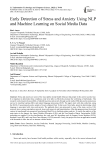
Early Detection of Stress and Anxiety Using NLP and Machine Learning on Social Media Data
Статья научная
Stress and anxiety are some of the most public mental health illnesses that people in the current society face. It is important to determine these conditions early to be able to effectively promote the well-being of individuals. This research work presents the possibility of identifying stress and anxiety through social media (SM) data and an anonymous survey, by machine learning (ML) and natural language processing (NLP). The paper starts with data collection, using the DASS-21 questionnaire and a sample of tweets obtained from Twitter users from India, aimed at determining which language is associated with stress and anxiety. The gathered data is pre-processed in some of the steps, such as URL removal, lower casing, punctuation removal, stop words removal, and lemmatization. After data preprocessing, the textual content is transformed into numerical form through Word2Vec to facilitate pattern analysis. To enrich the analysis of the main topics in the dataset, the Latent Dirichlet Allocation (LDA) and the Non-Negative Matrix Factorization (NMF) techniques are applied. For the classification, the work uses ML algorithms such as Support Vector Machine (SVM), Random Forest (RF), and Long Short-Term Memory (LSTM) networks. Lastly, the project involves an application created with Streamlit to allow the user to interact with the model.
Бесплатно
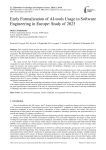
Early Formalization of AI-tools Usage in Software Engineering in Europe: Study of 2023
Статья научная
This scientific article presents the results of a study focused on the current practices and future prospects of AI-tools usage, specifically large language models (LLMs), in software development (SD) processes within European IT companies. The Pan-European study covers 35 SD teams from all regions of Europe and consists of three sections: the first section explores the current adoption of AI-tools in software production, the second section addresses common challenges in LLMs implementation, and the third section provides a forecast of the tech future in AI-tools development for SD. The study reveals that AI-tools, particularly LLMs, have gained popularity and approbation in European IT companies for tasks related to software design and construction, coding, and software documentation. However, their usage for business and system analysis remains limited. Nevertheless, challenges such as resource constraints and organizational resistance are evident. The article also highlights the potential of AI-tools in the software development process, such as automating routine operations, speeding up work processes, and enhancing software product excellence. Moreover, the research examines the transformation of IT paradigms driven by AI-tools, leading to changes in the skill sets of software developers. Although the impact of LLMs on the software development industry is perceived as modest, experts anticipate significant changes in the next 10 years, including AI-tools integration into advanced IDEs, software project management systems, and product management tools. Ethical concerns about data ownership, information security and legal aspects of AI-tools usage are also discussed, with experts emphasizing the need for legal formalization and regulation in the AI domain. Overall, the study highlights the growing importance and potential of AI-tools in software development, as well as the need for careful consideration of challenges and ethical implications to fully leverage their benefits.
Бесплатно
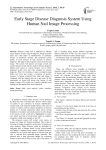
Early Stage Disease Diagnosis System Using Human Nail Image Processing
Статья научная
Human's hand nail is analyzed to identify many diseases at early stage of diagnosis. Study of person hand nail color helps in identification of particular disease in healthcare domain. The proposed system guides in such scenario to take decision in disease diagnosis. The input to the proposed system is person nail image. The system will process an image of nail and extract features of nail which is used for disease diagnosis. Human nail consist of various features, out of which proposed system uses nail color changes for disease diagnosis. Here, first training set data is prepared using Weka tool from nail images of patients of specific diseases. A feature extracted from input nail image is compared with the training data set to get result. In this experiment we found that using color feature of nail image average 65% results are correctly matched with training set data during three tests conducted.
Бесплатно
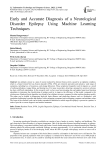
Early and Accurate Diagnosis of a Neurological Disorder Epilepsy Using Machine Learning Techniques
Статья научная
An epileptic seizure is a type of seizure induced by aberrant brain activity caused by an epileptic condition, which is a brain Central Nervous System disorder (CNS). CNSs are relatively prevalent and include a wide range of symptoms, including loss of awareness, and strange behaviour. These symptoms frequently result in injuries as a result of walking imbalance, tongue biting, and hearing loss. For many researchers, detecting a prospective seizure in advance has been a difficult undertaking. In this research work we have used non-imaging data and applied supervised learning algorithms to determine the classification of epilepsy and try to improve the efficiency of the model, compared to the existing ones. Random Forest algorithm was found to have highest accuracy compared to other machine learning models. The paper can be helpful in diagnosing high-risk brain diseases and predicting diseases such as Alzheimer's with symptoms challenging to predict and diseases with overlapping symptoms and overlapping symptoms and attribute values. The scope of the research work can be further extended to determine at which stage the epilepsy is present in a patient, in order to provide a correct diagnosis and medical treatment.
Бесплатно
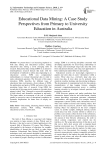
Educational data mining: a case study perspectives from primary to university education in Australia
Статья научная
At present there is an increasing emphasis on both data mining and educational systems, making educational data mining a novel emerging field of research. Educational data mining (EDM) is an attractive interdisciplinary research domain that deals with the development of methods to utilise data originating in an educational context. EDM uses computational methodologies to evaluate educational data in order to study educational questions. The first part of this paper introduces EDM, describes the different types of educational data environments, diverse phases of EDM, the applications and goals of EDM, and some of the most promising future lines of research. Using EDM, the second part of this paper tracks students in Australia from primary school Year 1 through to successful completion of high school, and, thereafter, enrolment in university. The paper makes an assessment of the role of student gender on successive rates of educational completion in Australia. Implications for future lines of enquiry are discussed.
Бесплатно
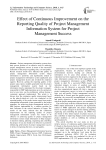
Статья научная
Project management information systems have their proven position as an effective tool for achieving project management success in terms of the successful realization of the project regarding time, cost and quality. Recent research results have indicated that quality of project management information system output information is positively and significantly related to project management information system application and project management factors and revealed the empirical support. However, getting the reporting quality of the project status report, monthly generated from the project management information system based on the information timely maintained by the project managers, responsible for ERP implementation up to the satisfactory level at any time, can be problematic without having a systematic approach implemented. This article is to discuss how the continuous quality improvement based on the plan-do-check-act cycle was conducted on the reporting quality of the project status report from project management information system generated by the project managers, for achieving project management success in ERP projects implemented by a solution provider for their customers in the various industries in Japan. The results of the study indicate that the continuous improvement on the reporting quality of project management information system was found to be effective in achieving quality of project management information system output information to help managers in decision making, planning, organizing and controlling the project. It was also found to be effective in positively influencing achievement of project management success in terms of respecting the time, cost and quality.
Бесплатно
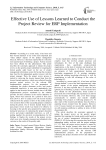
Effective use of lessons learned to conduct the project review for ERP implementation
Статья научная
According to a recent study, it has been said that “lessons learned” is one of the most important and “value added” aspects of the project management lifecycle. However, it has been reported that it is often the most ignored part of finishing a project. Various reasons have been offered for this phenomenon. This article describes the systematic approach to initiate the project review on the specific project identified for requiring the formal quality audit based on the use of project management information system for having the execution date fixed by the independent quality reviewer with the project manager. Then, the project review process is started by retrieving the lessons learned data from the lessons learned repository, which were collected from the previous project reviews for the relevant ERP implementation projects, for the preparation of conducting the project document review and project stakeholder interviews. A case study methodology was applied to the historical lessons learned data of the ERP implementation projects conducted by the solution provider for their customers in the various industries in Japan, which were retrieved for a period of four years from 2014 to 2017 to analyze how the lessons learned collected from the project reviews of the earlier projects were reused in those of the succeeding projects conducted during the period. Use of lessons learned based on the past project review results was found to be effective in focusing on the specific areas projected for improvement during the processes of conducting the project document review and project stakeholder interviews, as well as putting together the practical recommendations for the findings to finalize the results of the project review, which were to be formally presented and submitted to the customer as the results of the quality audit.
Бесплатно
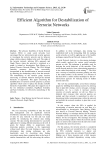
Efficient Algorithm for Destabilization of Terrorist Networks
Статья научная
The advisory feasibility of Social Network Analysis (SNA) to study social networks have encouraged the law enforcement and security agencies to investigate the terrorist network and its behavior along with key players hidden in the web. The study of the terrorist network, utilizing SNA approach and Graph Theory where the network is visualized as a graph, is termed as Investigative Data Mining or in general Terrorist Network Mining. The SNA defined centrality measures have been successfully incorporated in the destabilization of terrorist network by deterring the dominating role(s) from the network. The destabilizing of the terrorist group involves uncovering of network behavior through the defined hierarchy of algorithms. This paper concerning the destabilization of terrorist network proposes a pioneer algorithm which seems to replace the already available hierarchy of algorithms. This paper also suggests use of the two influential centralities, PageRank Centrality and Katz Centrality, for effectively neutralizing of the network.
Бесплатно
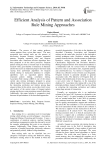
Efficient Analysis of Pattern and Association Rule Mining Approaches
Статья научная
The process of data mining produces various patterns from a given data source. The most recognized data mining tasks are the process of discovering frequent itemsets, frequent sequential patterns, frequent sequential rules and frequent association rules. Numerous efficient algorithms have been proposed to do the above processes. Frequent pattern mining has been a focused topic in data mining research with a good number of references in literature and for that reason an important progress has been made, varying from performant algorithms for frequent itemset mining in transaction databases to complex algorithms, such as sequential pattern mining, structured pattern mining, correlation mining. Association Rule mining (ARM) is one of the utmost current data mining techniques designed to group objects together from large databases aiming to extract the interesting correlation and relation among huge amount of data. In this article, we provide a brief review and analysis of the current status of frequent pattern mining and discuss some promising research directions. Additionally, this paper includes a comparative study between the performance of the described approaches.
Бесплатно
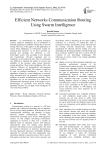
Efficient Networks Communication Routing Using Swarm Intelligence
Статья научная
As demonstrated by natural biological swarm’s collective intelligence has an abundance of desirable properties for problem-solving like in network routing. The focus of this paper is in the applications of swarm based intelligence in information routing for communication networks. As we know networks are growing and adopting new platforms as new technologies comes. Also according to new demands and requirements networks topologies and its complexity is increasing with time. Thus it is becoming very difficult to maintain the quality of services and reliability of the networks using current Networks routing algorithms. Thus Swarm intelligence (SI) is the collective behavior of decentralized self-organized systems, natural or artificial. The concept is employed in work on artificial intelligence. A new class of algorithms, inspired by swarm intelligence is currently being developed that can potentially solve numerous problems of modern communications networks. These algorithms rely on the interaction of a multitude of simultaneously interacting agents. In this paper we give disadvantages of previously used network routing algorithms and how we can apply swarm intelligence to overcome these problems.
Бесплатно
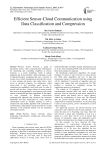
Efficient Sensor-Cloud Communication using Data Classification and Compression
Статья научная
Wireless Sensor Network, a group of specialized sensors with a communication infrastructure for monitoring and controlling conditions at diverse locations, is a recent technology which is getting popularity day by day. Besides, cloud computing is a type of high-performance computing that uses a network of remote servers which simultaneously provides the service to store, manage and process data rather than a local server or personal computer. An architecture called sensor-cloud is also providing good services by combining the capabilities from both ends. In order to provide such services, a large volume of sensor network data needs to be transported to cloud gateway with a high amount of bandwidth and time requirement. In this paper, we have proposed an efficient sensor-cloud communication approach that minimizes the enormous bandwidth and time requirement by using statistical classification based on machine learning as well as compression using deflate algorithm with a minimal loss of information. Experimental results describe the overall efficiency of the proposed method over the traditional and related research.
Бесплатно
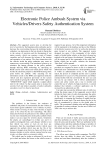
Electronic police ambush system via vehicles/drivers safety authentication system
Статья научная
The suggested system aims to develop the level of security for the Egyptian police ambushes and to decrease the overcrowding because the traditional police ambushes was depressing in the last decade in Egypt due to the actions of terrorism and the threatening of our nation security, which was causing a waste of human casualties and will decrease the income of the tourism and reputation of our nations. The direct interaction with the vehicles inside the police ambushes may cause an unnecessary overcrowding. The introduced system try to minimize the human element in the police ambush through utilizing RFID technology by specifying an RFID card for each vehicle and vehicle driver which will be like the electronic passport at the RFID Sensing check point before the ambush. After checking for the information saved on the RFID card supposed inside the vehicle and also registered previously on the system server results in giving the vehicle the “PASS” signal or “ARRESSTED” signal which required a capture photo shot for the vehicle. So that system aims to increase the security level and reduce casualties of police ambushes anywhere even if it is fixed or non-fixed.
Бесплатно
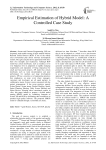
Empirical Estimation of Hybrid Model: A Controlled Case Study
Статья научная
Scrum and Extreme Programming (XP) are frequently used models among all agile models whereas Rational Unified Process (RUP) is one of the widely used conventional plan driven software development models. The agile and plan driven approaches both have their own strengths and weaknesses. Although RUP model has certain drawbacks, such as tendency to be over budgeted, slow in adaptation to rapidly changing requirements and reputation of being impractical for small and fast paced projects. XP model has certain drawbacks such as weak documentation and poor performance for medium and large development projects. XP has a concrete set of engineering practices that emphasizes on team work where managers, customers and developers are all equal partners in collaborative teams. Scrum is more concerned with the project management. It has seven practices namely Scrum Master, Scrum teams, Product Backlog, Sprint, Sprint Planning Meeting, Daily Scrum Meeting and Sprint Review. Keeping above mentioned context in view, this paper intends to propose a hybrid model naming SPRUP model by combining strengths of Scrum, XP and RUP by eliminating their weaknesses to produce high quality software. The proposed SPRUP model is validated through a controlled case study.
Бесплатно
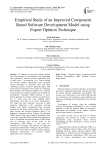
Статья научная
IT industry in the present market situation faces high demand for performance and burgeoning user expectations; with the pressure manifesting itself in three forms – Development Cost, Time-to-market and Product Quality. Researchers have proposed several techniques to effectively deal with these conflicting scenarios and draw optimized output. One of the relevant techniques in this context is Component Based Software Development (CBSD) with a targeted and discriminative approach influencing all phases of development. Although, CBSD proposes a multi-faceted approach in complex scenarios, its prime focus lies in “write once and reuse multiple times” methodology with either no or minor modifications. The model has been markedly successful in large enterprise applications with companies deriving benefits from shorter development time, increased productivity and better quality product. This research paper focuses and discusses Empirical Study of an Improved Component Based Software Development (ICBD) Model using Expert Opinion Technique which covers both component based software development as well as Component development phases. ICBD Model tries to overcome some of the issues in the contemporary CBD Models. A case study was conducted to investigate and evaluate our model by experienced professionals working in the IT industry. Results have shown that our improved model registers significant improvement over previous models suggested by other researchers.
Бесплатно

